Rockies’ Nolan Arenado adding extra level to his already-elite hitting
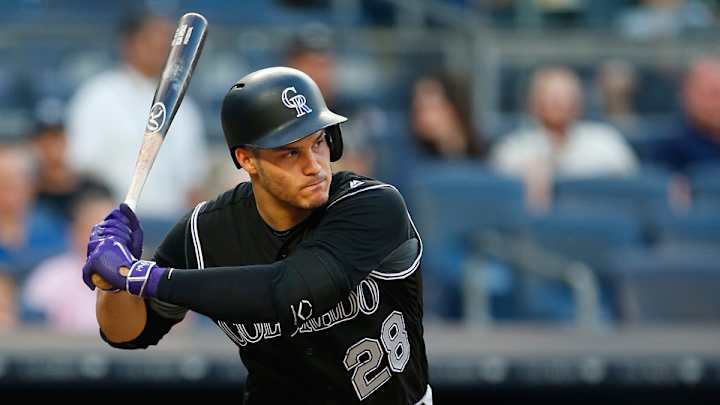
Your teams. Your favorite writers. Wherever you want them. Personalize SI with our new App. Install on iOS or Android.
Nolan Arenado’s career trajectory has followed the exact path you’d expect to see from a young superstar. He hit .267/.301/.405 with 10 homers while winning his first Gold Glove at 22 years old in his rookie season of 2013. He won another Gold Glove the following year, slashing .287/.328/.500 with 18 homers and 34 doubles. He then took an exponential leap last season, belting 42 homers, driving in 130 runs, and hitting .287/.323/.595, while of course, winning his third consecutive Gold Glove.
Upward trajectories can only last so long. No matter how good and how young a player is, at some point he’s going to reach his production ceiling. That doesn’t mean he’ll fall off, but rather his production will hit that ceiling and then level off as the player settles into his physical prime. It wouldn’t have been a shock, or even a disappointment, if Arenado’s breakout 2015 season represented the end of his upward trajectory. Fortunately for the Rockies and his fantasy owners, it didn’t.
As impossible as it might seem, Arenado has been better across the board this season than he was a year ago. Through 311 plate appearances—just less than half of what he had last season—Arenado is hitting .296/.373/.588 with 21 homers and 61 RBI. He leads the majors in home runs, is second to Edwin Encarnacion in RBI, and is one of two players with a combined 110 runs and RBI (the other is Mookie Betts). Arenado’s .588 slugging percentage is good for fourth in the league, and he checks in fifth with a .295 ISO. He is, without question, one of the game’s three best power hitters.
Arenado’s growth this season isn’t simply represented by him getting better in the areas he was already elite, though he has done that. He has also improved one key trait where he was merely average, and that has helped close off the one whole in his game.
Strikeouts have never been a huge issue for Arenado. He had a 14.6% strikeout rate over his first three years, with a single-season high of 16.5% last year, not a huge surprise given the monstrous power gains he made. He has also never been confused with a patient hitter, amassing a career 5% walk rate heading into this season. In the first three years of his career Arenado put a lot of balls in play, and he did so increasingly with authority.
• Hitting Report: Blue Jays’ hot streaks at the plate a pitcher’s nightmare
Arenado is still doing both of those things, though with a different mix. Coming into 2016, Arenado’s career walk and strikeout rates added up to 20.1%. This season, their sum essentially the same, at 21.2%, but the components are different. Arenado’s walk rate is 9.9%, while his strikeout rate is down to 11.3%. That’s the 10th-lowest K-rate in the majors. Among the 33 players with at least 15 homers, the next lowest strikeout rate is Carlos Santana’s 13.1%. Not including Arenado, their average strikeout rate is 21.8%. Areando’s ability to avoid strikeouts has transformed from strong to elite among MLB players as a whole. Specifically within the subset of power hitters, it is a major outlier.
How has Arenado cut his strikeouts and increased his walks to find a new level of performance in his age-25 season? Mostly by swinging less. His swing rate this season is 47.6%, down from 54.1% last year, which matched his career rate. From 2013 through ’15, only nine players in the majors swung at a greater share of pitches seen than Arenado. This season, he isn’t even in the top 60.
Arenado isn’t only swinging less frequently. He’s laying off pitches out of the zone with much greater consistency. Let’s again go back to the first three seasons of Arenado’s career. From ’13 through ’15, only 11 major leaguers had an o-swing percentage, the rate at which a hitter swings at pitches outside the strike zone, higher than Arenado’s 39.4%. His lowest o-swing rate in an individual season was 37.3% in ’14. This year, he’s down to 33%, which is still higher than league average, but a vast improvement for the 25-year-old.
• Breaking down one of Clayton Kershaw’s seven walks this season
But wait, we can break it down even further. Arenado isn’t simply laying off more balls than he used to. He’s refusing to swing at the ones that gave him the most trouble in his first three seasons, and that’s the final key piece to the puzzle.
Arenado has always been a pull-heavy hitter. He hit more than 45% of his balls in play to the left side in both of the last two seasons. His spray chart, courtesy of Statcast, from last year displays that pull tendency pretty clearly.
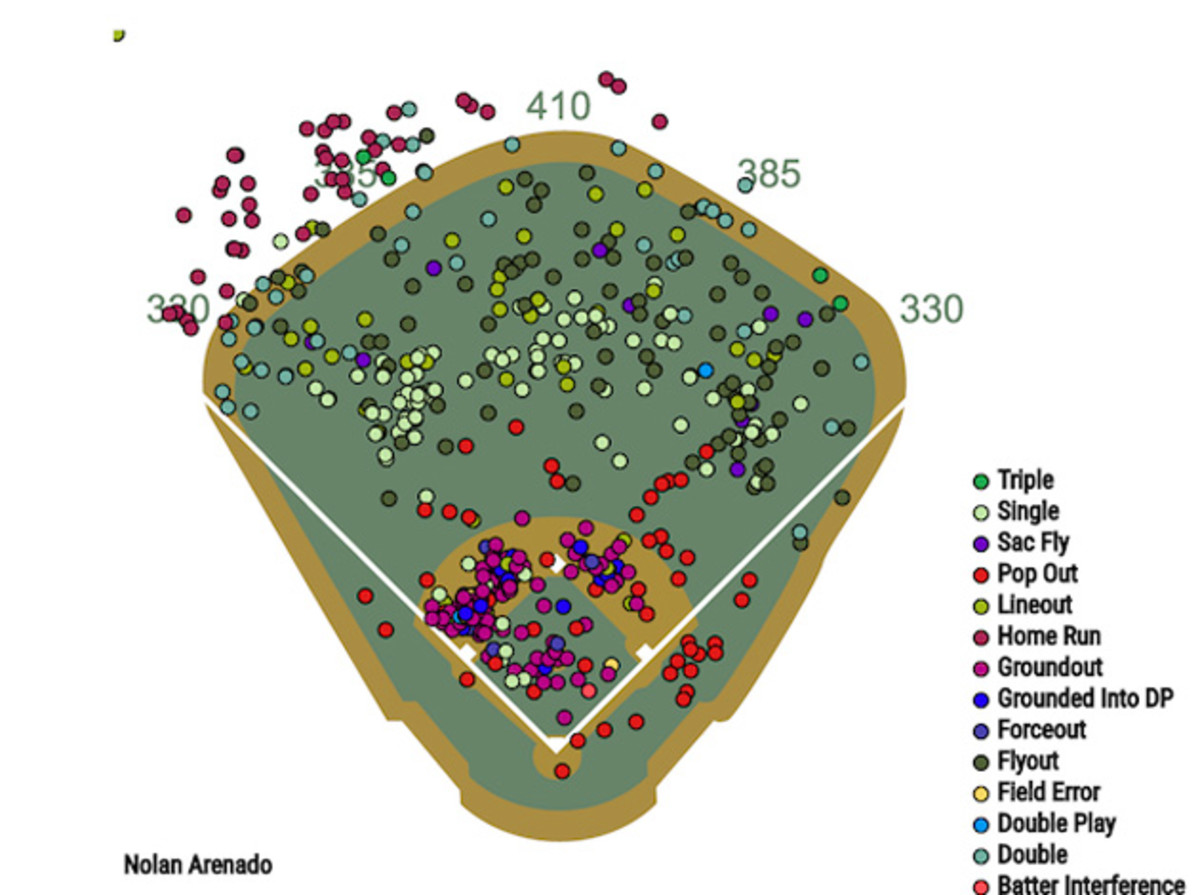
One thing that should jump out in that spray chart is that all but three of Arenado’s 42 homers last season were to left of straightaway center field. Nearly all of them were between straightaway left and the left field foul pole. Every hitter in the majors is going to hit the majority of their homers to their pull side, but this is extreme.
While part of Arenado’s pull-happiness is simply natural, another part is that he’s a better hitter on inside pitches. The following are Arenado’s batting average and ISO by zone for the first three seasons of his career.
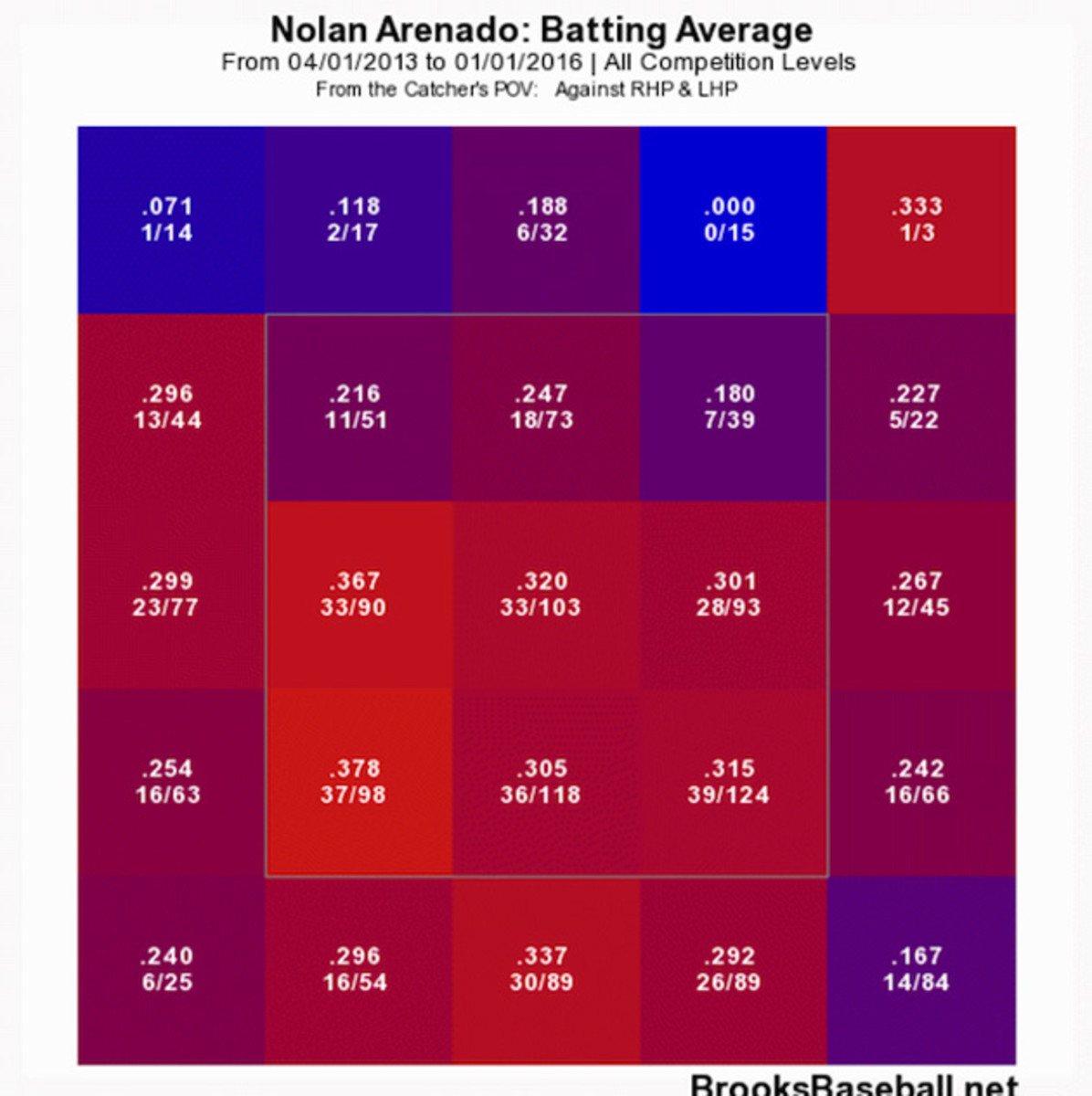
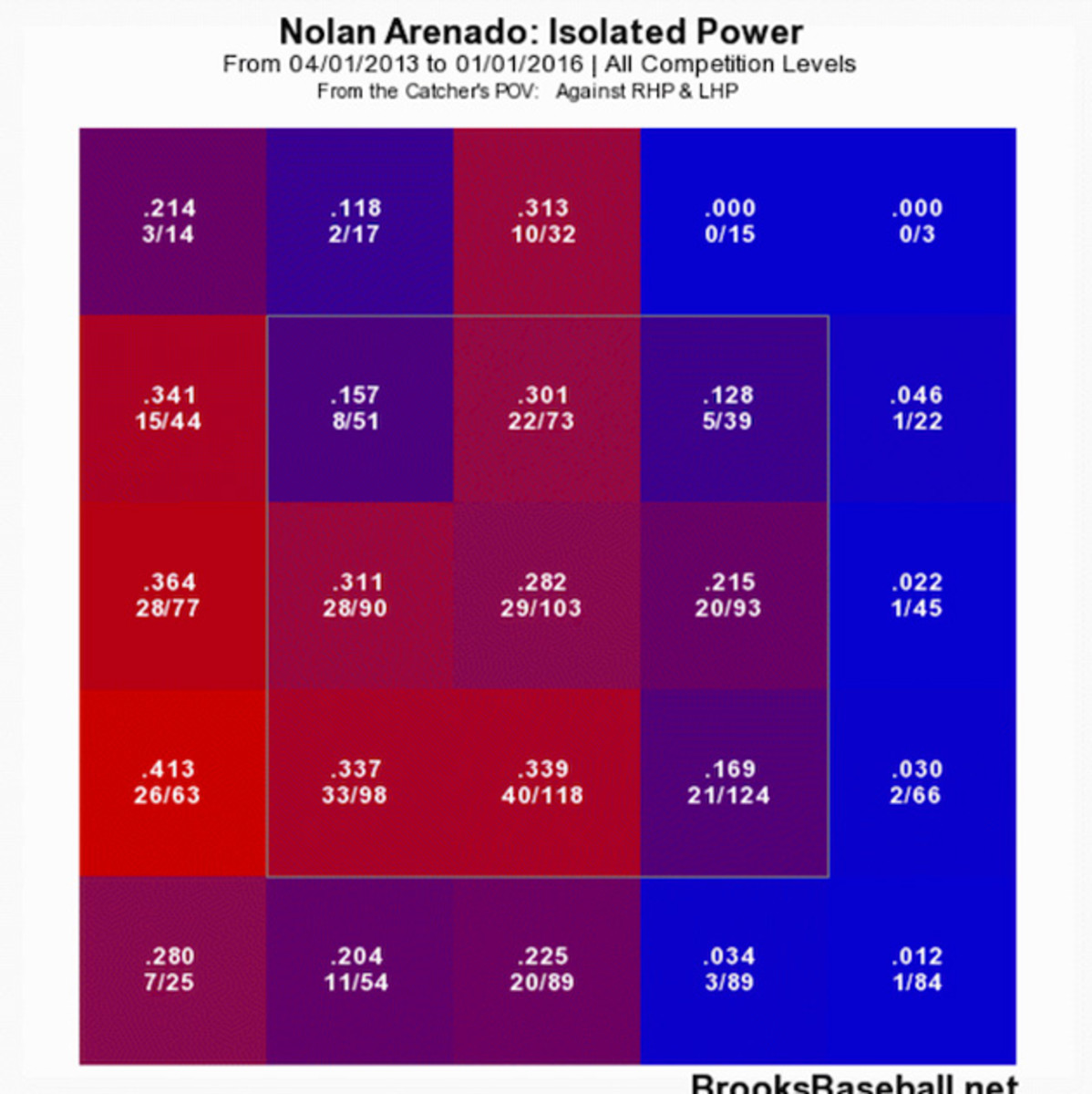
Arenado was better across the board on pitches either right down the middle (duh) or on the inner-third. Before this season, though, there wasn’t a significant difference in the way, or the frequency with which, he attacked pitches by zone. For the evidence, let’s go to Arenado’s swing rate by zone for ’13 through ’15.
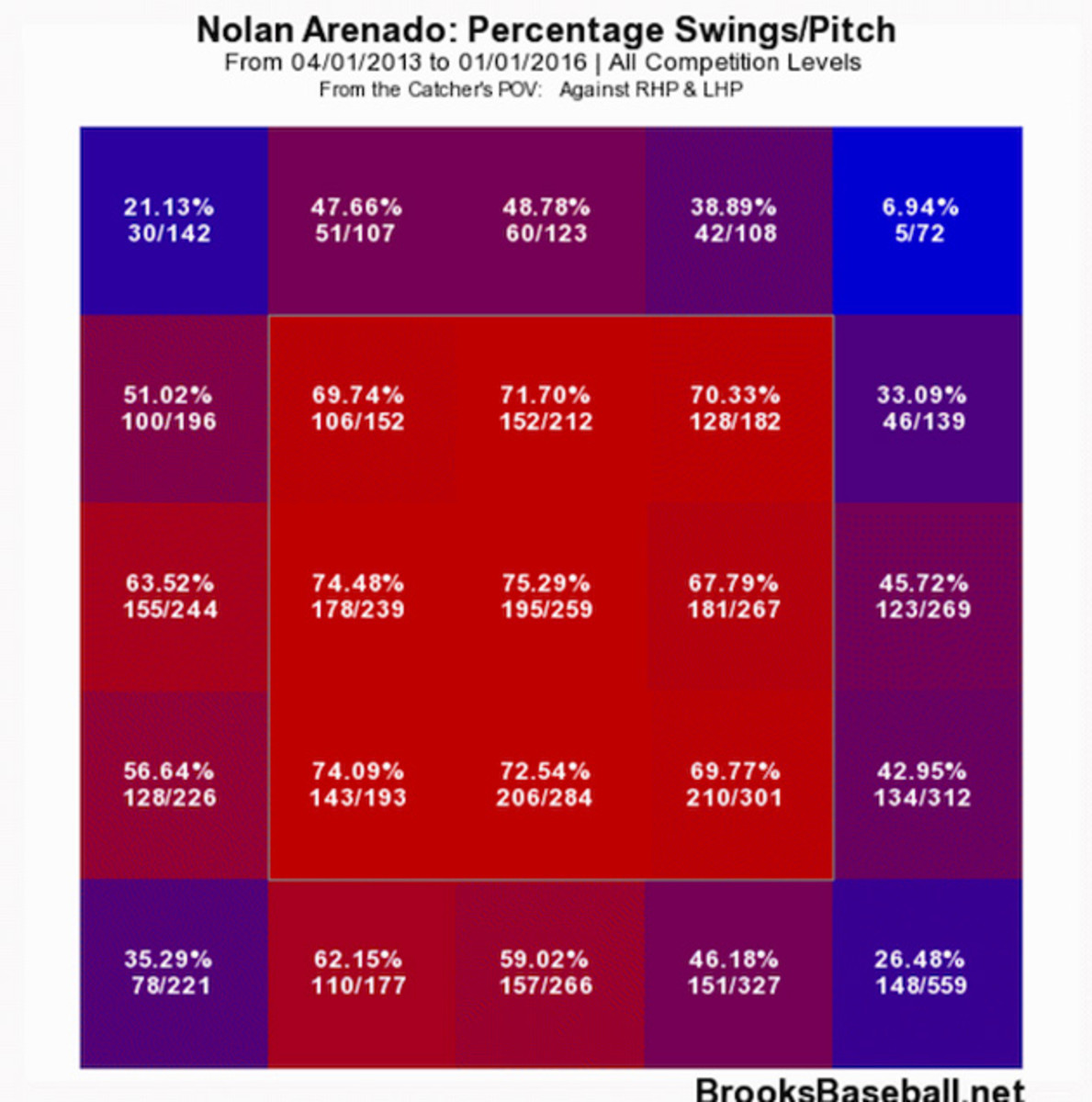
If a pitch was in the strike zone, Arenado wanted it. If it was below his shoulders but missed east or west, he still wanted it, just not quite as much. Clearly, Arenado was able to make things work just fine with this unfortunate tendency, but if he was going to make gains in 2016, this was the obvious place to focus.
We already know that Arenado has cut his swing and o-swing rates significantly this season. By now, you can probably guess in which zones he has experienced the largest declines.
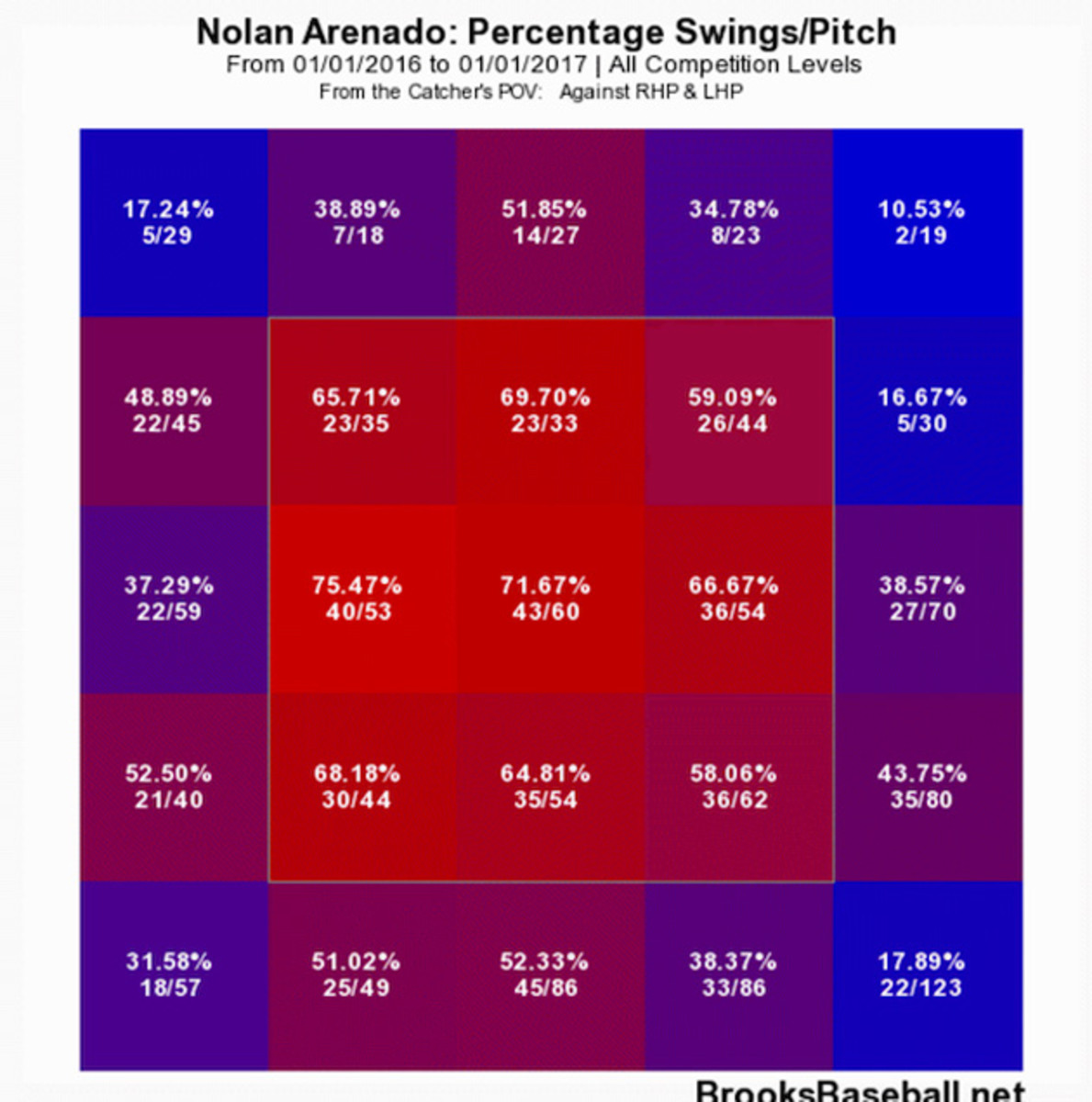
Take all of this into consideration, and you get a picture of a player who is really maturing in his age-25 season. Arenado is swinging less frequently, swinging at balls less frequently and swinging at the only tranche of pitches that gave him issues less frequently. All of that forces pitchers to challenge him more often where he wants them, out over the heart of the plate, on the inner-third, or even off the plate inside. As a result, Arenado is having the best season of his career. His trajectory is still moving upward.
